外研版(2019)选择性必修第一册Unit 1 Laugh out loud! 单元小测(含答案)
文档属性
| 名称 | 外研版(2019)选择性必修第一册Unit 1 Laugh out loud! 单元小测(含答案) | 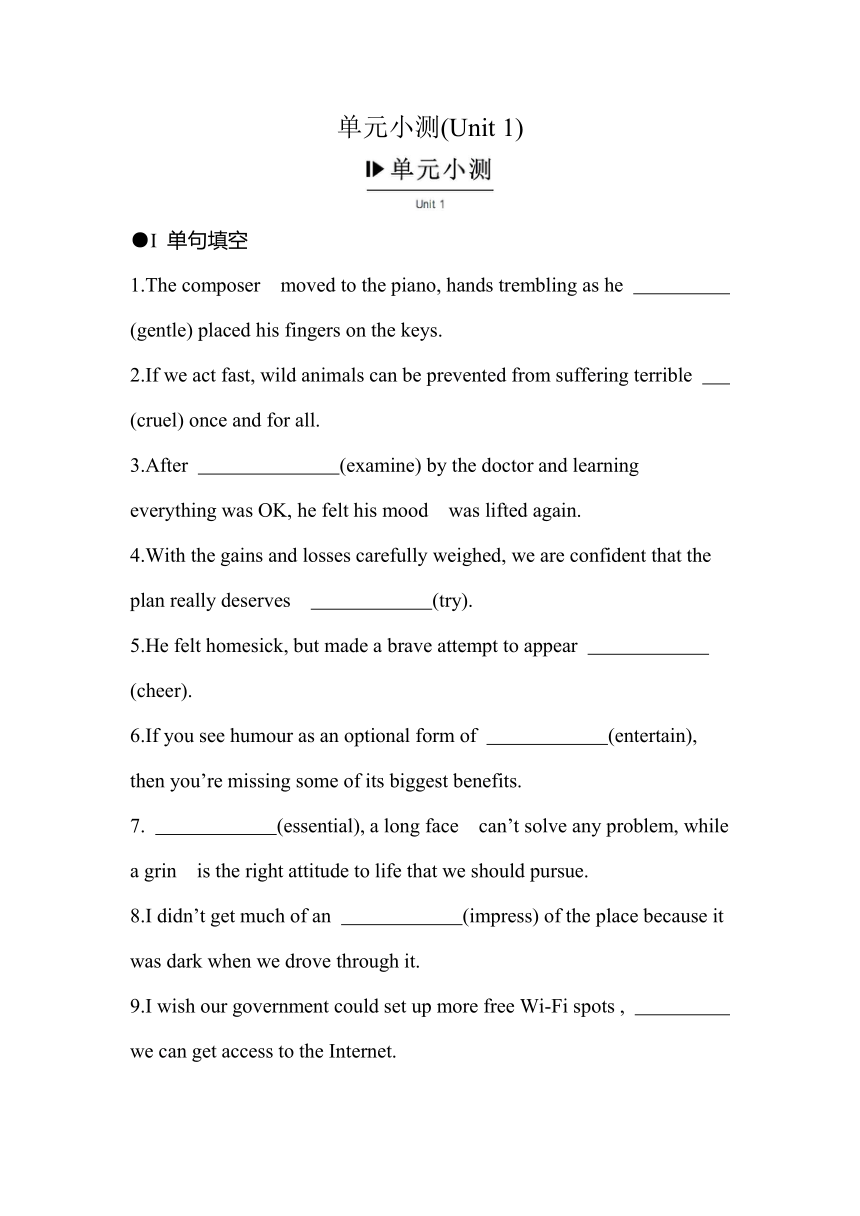 | |
| 格式 | docx | ||
| 文件大小 | 41.2KB | ||
| 资源类型 | 教案 | ||
| 版本资源 | 外研版(2019) | ||
| 科目 | 英语 | ||
| 更新时间 | 2024-10-11 12:14:19 | ||
图片预览

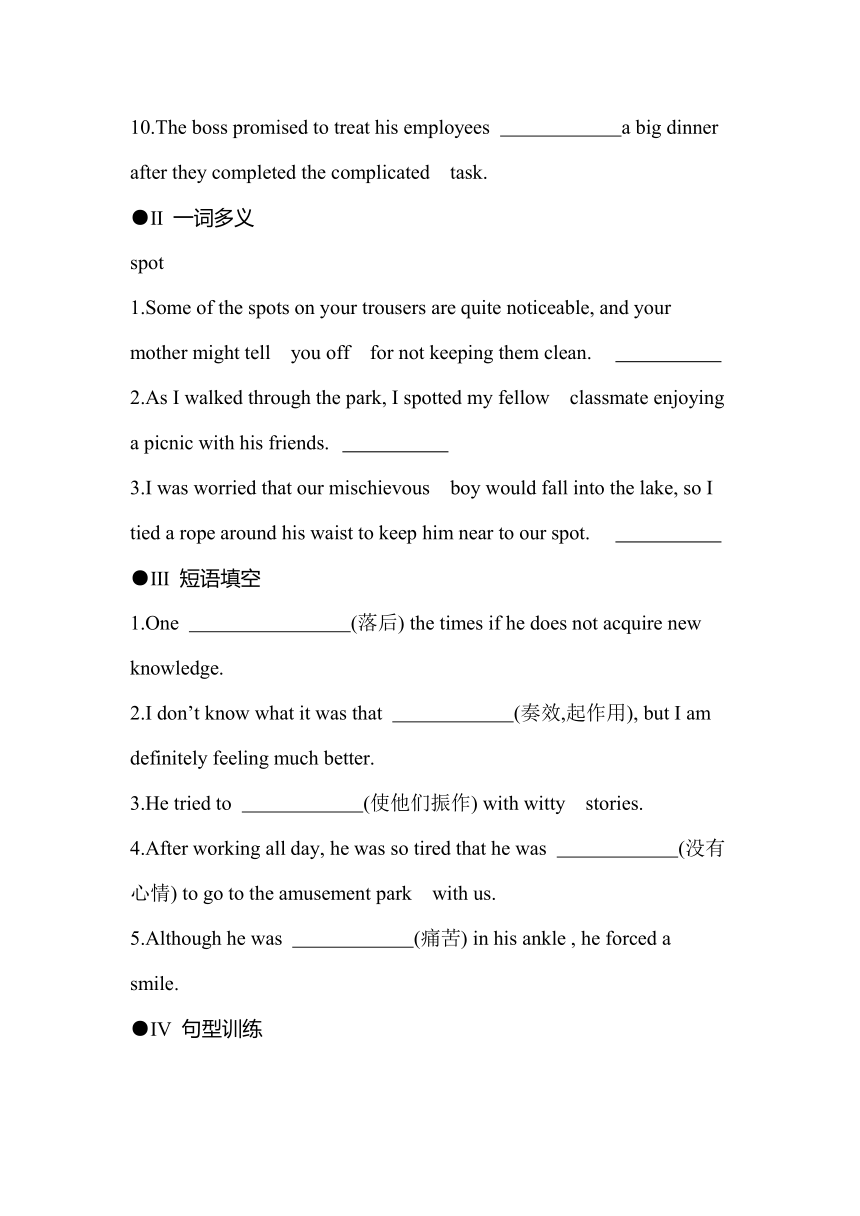
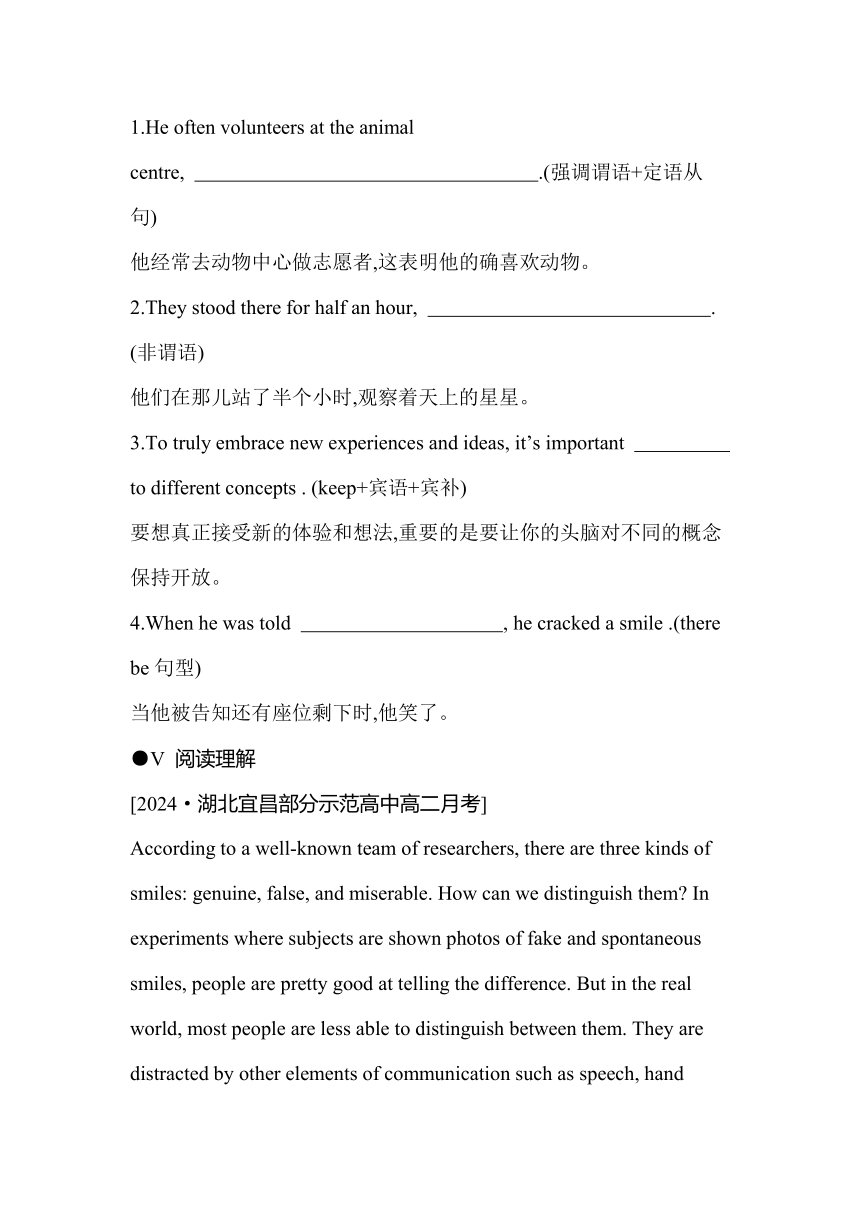
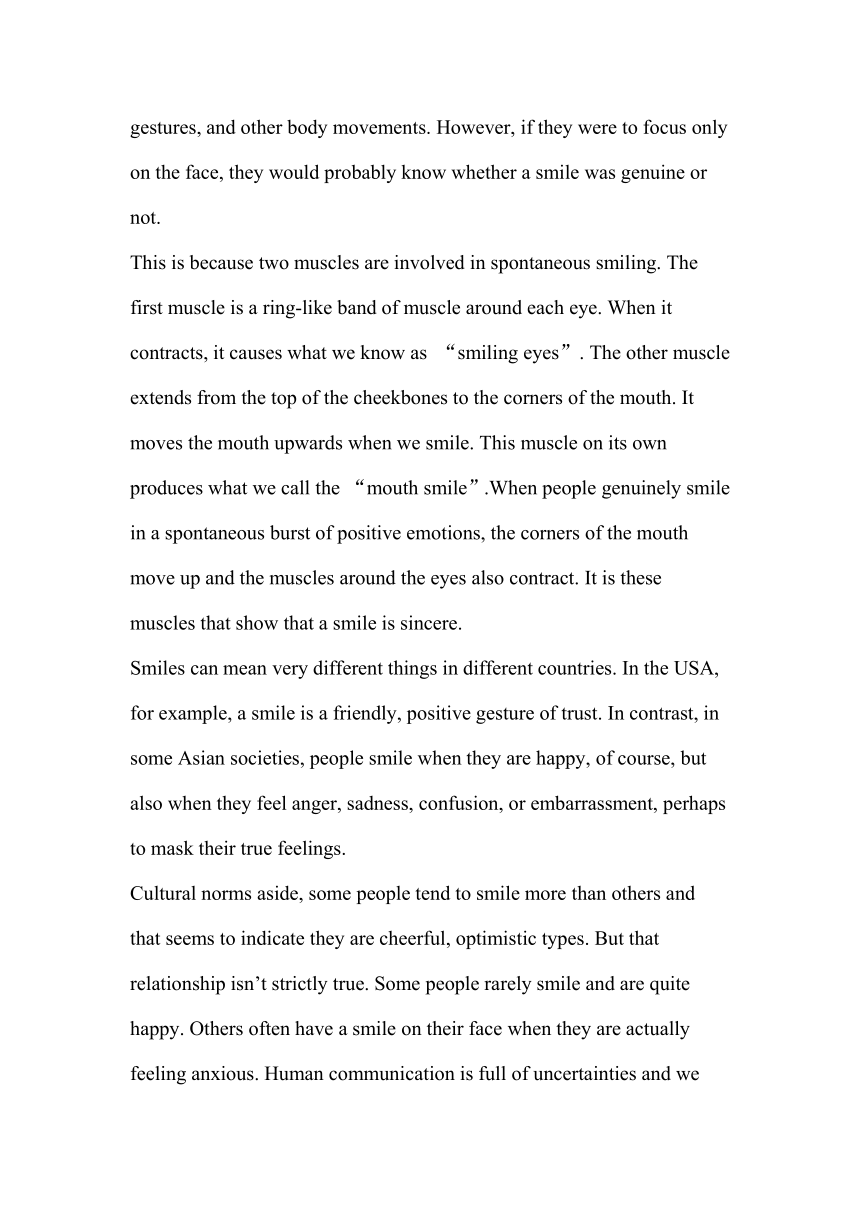
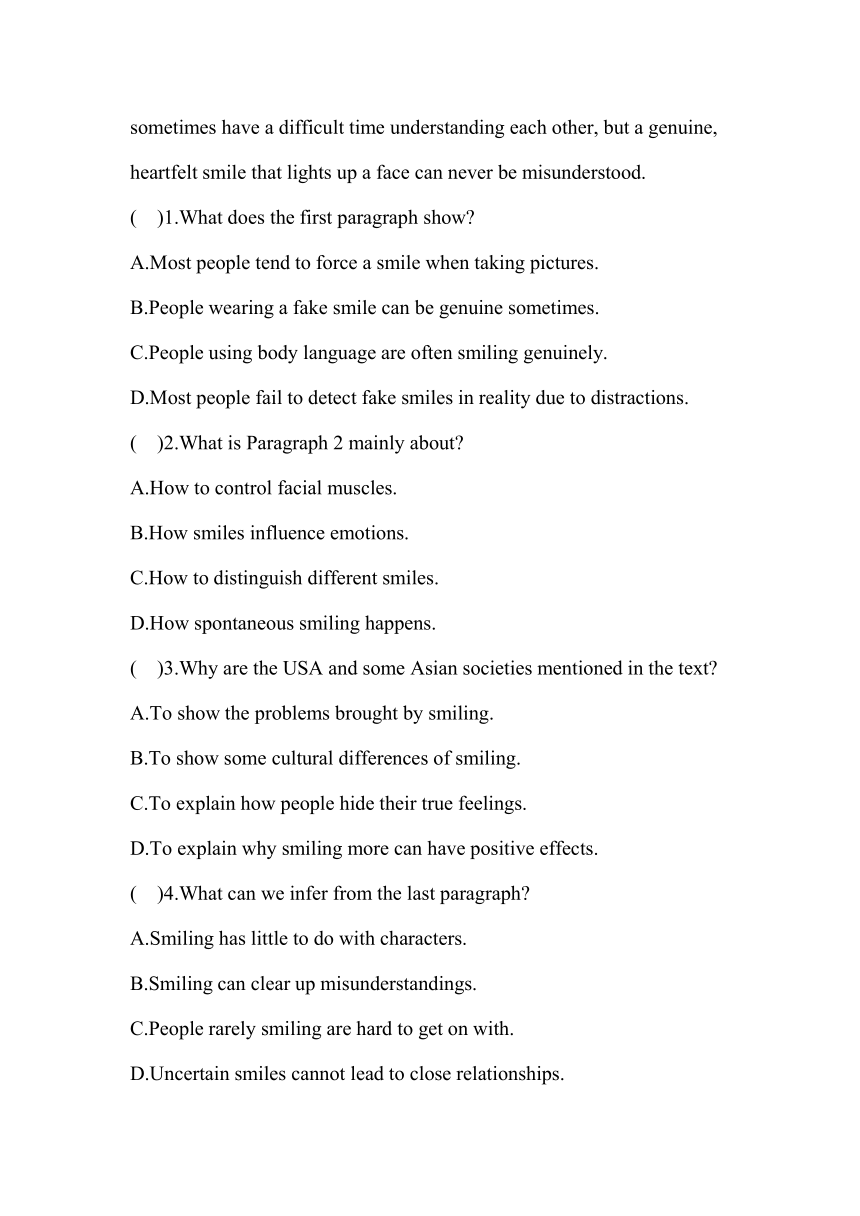
文档简介
单元小测(Unit 1)
●Ⅰ 单句填空
1.The composer moved to the piano, hands trembling as he (gentle) placed his fingers on the keys.
2.If we act fast, wild animals can be prevented from suffering terrible (cruel) once and for all.
3.After (examine) by the doctor and learning everything was OK, he felt his mood was lifted again.
4.With the gains and losses carefully weighed, we are confident that the plan really deserves (try).
5.He felt homesick, but made a brave attempt to appear (cheer).
6.If you see humour as an optional form of (entertain), then you’re missing some of its biggest benefits.
7. (essential), a long face can’t solve any problem, while a grin is the right attitude to life that we should pursue.
8.I didn’t get much of an (impress) of the place because it was dark when we drove through it.
9.I wish our government could set up more free Wi-Fi spots , we can get access to the Internet.
10.The boss promised to treat his employees a big dinner after they completed the complicated task.
●Ⅱ 一词多义
spot
1.Some of the spots on your trousers are quite noticeable, and your mother might tell you off for not keeping them clean.
2.As I walked through the park, I spotted my fellow classmate enjoying a picnic with his friends.
3.I was worried that our mischievous boy would fall into the lake, so I tied a rope around his waist to keep him near to our spot.
●Ⅲ 短语填空
1.One (落后) the times if he does not acquire new knowledge.
2.I don’t know what it was that (奏效,起作用), but I am definitely feeling much better.
3.He tried to (使他们振作) with witty stories.
4.After working all day, he was so tired that he was (没有心情) to go to the amusement park with us.
5.Although he was (痛苦) in his ankle , he forced a smile.
●Ⅳ 句型训练
1.He often volunteers at the animal centre, .(强调谓语+定语从句)
他经常去动物中心做志愿者,这表明他的确喜欢动物。
2.They stood there for half an hour, . (非谓语)
他们在那儿站了半个小时,观察着天上的星星。
3.To truly embrace new experiences and ideas, it’s important to different concepts . (keep+宾语+宾补)
要想真正接受新的体验和想法,重要的是要让你的头脑对不同的概念保持开放。
4.When he was told , he cracked a smile .(there be句型)
当他被告知还有座位剩下时,他笑了。
●Ⅴ 阅读理解
[2024·湖北宜昌部分示范高中高二月考]
According to a well-known team of researchers, there are three kinds of smiles: genuine, false, and miserable. How can we distinguish them In experiments where subjects are shown photos of fake and spontaneous smiles, people are pretty good at telling the difference. But in the real world, most people are less able to distinguish between them. They are distracted by other elements of communication such as speech, hand gestures, and other body movements. However, if they were to focus only on the face, they would probably know whether a smile was genuine or not.
This is because two muscles are involved in spontaneous smiling. The first muscle is a ring-like band of muscle around each eye. When it contracts, it causes what we know as “smiling eyes”. The other muscle extends from the top of the cheekbones to the corners of the mouth. It moves the mouth upwards when we smile. This muscle on its own produces what we call the “mouth smile”.When people genuinely smile in a spontaneous burst of positive emotions, the corners of the mouth move up and the muscles around the eyes also contract. It is these muscles that show that a smile is sincere.
Smiles can mean very different things in different countries. In the USA, for example, a smile is a friendly, positive gesture of trust. In contrast, in some Asian societies, people smile when they are happy, of course, but also when they feel anger, sadness, confusion, or embarrassment, perhaps to mask their true feelings.
Cultural norms aside, some people tend to smile more than others and that seems to indicate they are cheerful, optimistic types. But that relationship isn’t strictly true. Some people rarely smile and are quite happy. Others often have a smile on their face when they are actually feeling anxious. Human communication is full of uncertainties and we sometimes have a difficult time understanding each other, but a genuine, heartfelt smile that lights up a face can never be misunderstood.
( )1.What does the first paragraph show
A.Most people tend to force a smile when taking pictures.
B.People wearing a fake smile can be genuine sometimes.
C.People using body language are often smiling genuinely.
D.Most people fail to detect fake smiles in reality due to distractions.
( )2.What is Paragraph 2 mainly about
A.How to control facial muscles.
B.How smiles influence emotions.
C.How to distinguish different smiles.
D.How spontaneous smiling happens.
( )3.Why are the USA and some Asian societies mentioned in the text
A.To show the problems brought by smiling.
B.To show some cultural differences of smiling.
C.To explain how people hide their true feelings.
D.To explain why smiling more can have positive effects.
( )4.What can we infer from the last paragraph
A.Smiling has little to do with characters.
B.Smiling can clear up misunderstandings.
C.People rarely smiling are hard to get on with.
D.Uncertain smiles cannot lead to close relationships.
●Ⅵ 阅读七选五
[2024·山东德州实验中学高二期中]
I believe almost everyone would like two things from their jobs and careers: success and happiness. They want to do relatively well financially, receive fair recognition for their accomplishments, enjoy their work as much as one can, and become happier as a person as a result. So many people, especially ambitious, hard-working people, simplify them in a logical way: they first seek success and then assume that success will lead to happiness. 1. . Chasing success has cost that can end up lowering happiness.
This is not to say that you have to choose between success and happiness. 2. . But you have to reverse (颠倒) the order of operations: instead of trying first to get success and hoping it leads to happiness, start by working on your happiness, which will enhance your success.
Whether you are an employee or employer , it is a better investment to increase happiness at work and in life, rather than simply trying to increase measures of success.
3. . No matter how much you enjoy your work, overwork will become an obstruction (阻碍) to well-being.
Once work quantity is under control, happiness at work requires a sense of meaning and purpose. 4. . Earned success implies a sense of accomplishment and recognition for a job well done, while service to others requires knowledge of the real people who benefit from your work.
Ultimately, although success and happiness are linked, the magic mostly works one-way—and not in the way that most people think. 5. , and may lead you to unhappiness. But working on your happiness gives you the best chance of getting both.
A.You can obtain both
B.But this reasoning is faulty
C.It’s fairly reasonable to think this way, though
D.It’s dangerous to pursue success instead of happiness
E.The first thing to remember is that happiness requires balance
F.Working on your success to get happier is inefficient at best (充其量)
G.The two key aspects of meaningful work are earned success and service to others
●Ⅶ 语法填空
It is very possible to liven up a history lesson. Believe it or not, one 1. (power) way is through the use of technology. What surprises us most is when history goes high-tech, great things can happen! Here are a few ideas.
Produce newspaper 2. (article) about historical events or figures. Students can get as creative as they’d like. Perhaps they’d like to pretend to interview 3. person in history to get a “first-hand” idea of what life 4. (be) like at that time. Free online tools make this type 5. activity fun for students, and these tools can 6. (use) to record research and ideas.
Bring digital storytelling to the classroom. Digital storytelling employs the use of various software programs, 7. (allow) students to create historical documentaries. Moviemaking comes alive as students gather texts, narrations (解说), images, videos, and audio (音频的) pieces to tell stories from history 8. are important to them. They are able 9. (put) their critical thinking and problem-solving skills to good use, along with much creativity.
History doesn’t have to be the subject that 10. (rapid) puts students to sleep. With a little thinking outside the box, in fact it can become a class that students rush to each morning.
单元小测(Unit 1)
Ⅰ.1.gently 2.cruelty 3.being examined 4.trying/to be tried 5.cheerful 6.entertainment 7.Essentially
8.impression 9.where 10.to
Ⅱ.1.n.污渍 2.vt.发现,注意到 3.n.位置,地点
Ⅲ.1.will fall behind 2.did the trick 3.cheer them up
4.in no mood 5.in pain
Ⅳ.1.which shows that he does like animals
2.watching the stars in the sky
3.to keep your mind open
4.there were still seats left
Ⅴ.【文章大意】 这是一篇说明文。文章主要说明了由于分心,大多数人在现实中无法察觉虚假的微笑。文章还解释了微笑是如何自然而然发生的以及微笑在不同的国家有不同的含义。
1.D 细节理解题。根据第一段“In experiments where subjects are shown photos of fake and spontaneous smiles, people are pretty good at telling the difference. But in the real world, most people are less able to distinguish between them. They are distracted by other elements of communication such as speech, hand gestures, and other body movements.”可知,由于分心,大多数人在现实中无法察觉虚假的微笑。故选D。
2.D 段落大意题。根据第二段“This is because two muscles are involved in spontaneous smiling. The first muscle is a ring-like band of muscle around each eye. When it contracts, it causes what we know as ‘smiling eyes’. The other muscle extends from the top of the cheekbones to the corners of the mouth. It moves the mouth upwards when we smile. This muscle on its own produces what we call the ‘mouth smile’. When people genuinely smile in a spontaneous burst of positive emotions, the corners of the mouth move up and the muscles around the eyes also contract. It is these muscles that show that a smile is sincere.”可知,第二段主要讲了自然的微笑是如何产生的。故选D。
3.B 推理判断题。根据倒数第二段“Smiles can mean very different things in different countries. In the USA, for example, a smile is a friendly, positive gesture of trust. In contrast, in some Asian societies, people smile when they are happy, of course, but also when they feel anger, sadness, confusion, or embarrassment, perhaps to mask their true feelings.”可推知,文中提到美国和一些亚洲国家是为了展示与微笑相关的文化差异。故选B。
4.A 推理判断题。根据最后一段“Cultural norms aside, some people tend to smile more than others and that seems to indicate they are cheerful, optimistic types. But that relationship isn’t strictly true. Some people rarely smile and are quite happy. Others often have a smile on their face when they are actually feeling anxious. Human communication is full of uncertainties and we sometimes have a difficult time understanding each other, but a genuine, heartfelt smile that lights up a face can never be misunderstood.”可推知,微笑与性格没什么关系。故选A。
Ⅵ.【文章大意】 本文是一篇议论文,说明了在工作中成功和快乐的关系并非非此即彼,而是互为补充,因此要处理好二者的关系。
1.B 上文“…they first seek success and then assume that success will lead to happiness.”说明了一些人的逻辑,与下文“Chasing success has cost that can end up lowering happiness.”是对立的关系,说明上文的逻辑是错误的。B项(但是这种推理是错误的)承上启下,符合题意。故选B项。
2.A 上文“This is not to say that you have to choose between success and happiness.”说明成功和快乐并不是矛盾的,是可以兼得的。故A项(你可以二者兼得)符合语境。故选A项。
3.E 下文“No matter how much you enjoy your work, overwork will become an obstruction (阻碍) to well-being.”说明快乐来自喜欢,但要懂得适度和平衡,否则再喜欢的工作也会变成阻碍。E项(要记住的第一件事就是快乐需要平衡)符合语境。故选E项。
4.G 下文“Earned success implies a sense of accomplishment and recognition for a job well done, while service to others requires knowledge of the real people who benefit from your work.”说明了earned success和service to others两方面的内容,与G项(有意义的工作的两个关键就是获得的成功和对他人的服务)中的两个关键一致。故选G项。
5.F 下文“…and may lead you to unhappiness.”说明前面的事情是不好的做法。结合下句“But working on your happiness gives you the best chance of getting both.”可知,前面的做法是与其相反的。故F项(致力于成功从而获得快乐充其量是效率低下的)符合语境。故选F项。
Ⅶ.【文章大意】 本文是一篇说明文。文章介绍了可以通过对技术的使用使历史课生动有趣起来。
1.powerful 考查形容词。名词way前应用形容词修饰。故填powerful。
2.articles 考查名词复数。article为可数名词,空格前没有限定词,所以用名词的复数形式。故填articles。
3.a 考查冠词。person为可数名词,此处表泛指。故填a。
4.was 考查时态。根据句中时间状语at that time可知,这里用一般过去时。故填was。
5.of 考查介词。短语this type of…意为“这类……”。故填of。
6.be used 考查动词语态。分句主语these tools与动词use是被动关系,且空格前有情态动词can。故填be used。
7.allowing 考查非谓语动词。逻辑主语digital storytelling与动词allow是主动关系,所以用现在分词作状语。故填allowing。
8.which/that 考查定语从句。从句的先行词为stories,指物,在定语从句中充当主语,所以用关系代词which或that引导。故填which/that。
9.to put 考查非谓语动词。短语be able to do sth意为“能够做某事”。故填to put。
10.rapidly 考查副词。动词puts前用副词修饰。故填rapidly。
●Ⅰ 单句填空
1.The composer moved to the piano, hands trembling as he (gentle) placed his fingers on the keys.
2.If we act fast, wild animals can be prevented from suffering terrible (cruel) once and for all.
3.After (examine) by the doctor and learning everything was OK, he felt his mood was lifted again.
4.With the gains and losses carefully weighed, we are confident that the plan really deserves (try).
5.He felt homesick, but made a brave attempt to appear (cheer).
6.If you see humour as an optional form of (entertain), then you’re missing some of its biggest benefits.
7. (essential), a long face can’t solve any problem, while a grin is the right attitude to life that we should pursue.
8.I didn’t get much of an (impress) of the place because it was dark when we drove through it.
9.I wish our government could set up more free Wi-Fi spots , we can get access to the Internet.
10.The boss promised to treat his employees a big dinner after they completed the complicated task.
●Ⅱ 一词多义
spot
1.Some of the spots on your trousers are quite noticeable, and your mother might tell you off for not keeping them clean.
2.As I walked through the park, I spotted my fellow classmate enjoying a picnic with his friends.
3.I was worried that our mischievous boy would fall into the lake, so I tied a rope around his waist to keep him near to our spot.
●Ⅲ 短语填空
1.One (落后) the times if he does not acquire new knowledge.
2.I don’t know what it was that (奏效,起作用), but I am definitely feeling much better.
3.He tried to (使他们振作) with witty stories.
4.After working all day, he was so tired that he was (没有心情) to go to the amusement park with us.
5.Although he was (痛苦) in his ankle , he forced a smile.
●Ⅳ 句型训练
1.He often volunteers at the animal centre, .(强调谓语+定语从句)
他经常去动物中心做志愿者,这表明他的确喜欢动物。
2.They stood there for half an hour, . (非谓语)
他们在那儿站了半个小时,观察着天上的星星。
3.To truly embrace new experiences and ideas, it’s important to different concepts . (keep+宾语+宾补)
要想真正接受新的体验和想法,重要的是要让你的头脑对不同的概念保持开放。
4.When he was told , he cracked a smile .(there be句型)
当他被告知还有座位剩下时,他笑了。
●Ⅴ 阅读理解
[2024·湖北宜昌部分示范高中高二月考]
According to a well-known team of researchers, there are three kinds of smiles: genuine, false, and miserable. How can we distinguish them In experiments where subjects are shown photos of fake and spontaneous smiles, people are pretty good at telling the difference. But in the real world, most people are less able to distinguish between them. They are distracted by other elements of communication such as speech, hand gestures, and other body movements. However, if they were to focus only on the face, they would probably know whether a smile was genuine or not.
This is because two muscles are involved in spontaneous smiling. The first muscle is a ring-like band of muscle around each eye. When it contracts, it causes what we know as “smiling eyes”. The other muscle extends from the top of the cheekbones to the corners of the mouth. It moves the mouth upwards when we smile. This muscle on its own produces what we call the “mouth smile”.When people genuinely smile in a spontaneous burst of positive emotions, the corners of the mouth move up and the muscles around the eyes also contract. It is these muscles that show that a smile is sincere.
Smiles can mean very different things in different countries. In the USA, for example, a smile is a friendly, positive gesture of trust. In contrast, in some Asian societies, people smile when they are happy, of course, but also when they feel anger, sadness, confusion, or embarrassment, perhaps to mask their true feelings.
Cultural norms aside, some people tend to smile more than others and that seems to indicate they are cheerful, optimistic types. But that relationship isn’t strictly true. Some people rarely smile and are quite happy. Others often have a smile on their face when they are actually feeling anxious. Human communication is full of uncertainties and we sometimes have a difficult time understanding each other, but a genuine, heartfelt smile that lights up a face can never be misunderstood.
( )1.What does the first paragraph show
A.Most people tend to force a smile when taking pictures.
B.People wearing a fake smile can be genuine sometimes.
C.People using body language are often smiling genuinely.
D.Most people fail to detect fake smiles in reality due to distractions.
( )2.What is Paragraph 2 mainly about
A.How to control facial muscles.
B.How smiles influence emotions.
C.How to distinguish different smiles.
D.How spontaneous smiling happens.
( )3.Why are the USA and some Asian societies mentioned in the text
A.To show the problems brought by smiling.
B.To show some cultural differences of smiling.
C.To explain how people hide their true feelings.
D.To explain why smiling more can have positive effects.
( )4.What can we infer from the last paragraph
A.Smiling has little to do with characters.
B.Smiling can clear up misunderstandings.
C.People rarely smiling are hard to get on with.
D.Uncertain smiles cannot lead to close relationships.
●Ⅵ 阅读七选五
[2024·山东德州实验中学高二期中]
I believe almost everyone would like two things from their jobs and careers: success and happiness. They want to do relatively well financially, receive fair recognition for their accomplishments, enjoy their work as much as one can, and become happier as a person as a result. So many people, especially ambitious, hard-working people, simplify them in a logical way: they first seek success and then assume that success will lead to happiness. 1. . Chasing success has cost that can end up lowering happiness.
This is not to say that you have to choose between success and happiness. 2. . But you have to reverse (颠倒) the order of operations: instead of trying first to get success and hoping it leads to happiness, start by working on your happiness, which will enhance your success.
Whether you are an employee or employer , it is a better investment to increase happiness at work and in life, rather than simply trying to increase measures of success.
3. . No matter how much you enjoy your work, overwork will become an obstruction (阻碍) to well-being.
Once work quantity is under control, happiness at work requires a sense of meaning and purpose. 4. . Earned success implies a sense of accomplishment and recognition for a job well done, while service to others requires knowledge of the real people who benefit from your work.
Ultimately, although success and happiness are linked, the magic mostly works one-way—and not in the way that most people think. 5. , and may lead you to unhappiness. But working on your happiness gives you the best chance of getting both.
A.You can obtain both
B.But this reasoning is faulty
C.It’s fairly reasonable to think this way, though
D.It’s dangerous to pursue success instead of happiness
E.The first thing to remember is that happiness requires balance
F.Working on your success to get happier is inefficient at best (充其量)
G.The two key aspects of meaningful work are earned success and service to others
●Ⅶ 语法填空
It is very possible to liven up a history lesson. Believe it or not, one 1. (power) way is through the use of technology. What surprises us most is when history goes high-tech, great things can happen! Here are a few ideas.
Produce newspaper 2. (article) about historical events or figures. Students can get as creative as they’d like. Perhaps they’d like to pretend to interview 3. person in history to get a “first-hand” idea of what life 4. (be) like at that time. Free online tools make this type 5. activity fun for students, and these tools can 6. (use) to record research and ideas.
Bring digital storytelling to the classroom. Digital storytelling employs the use of various software programs, 7. (allow) students to create historical documentaries. Moviemaking comes alive as students gather texts, narrations (解说), images, videos, and audio (音频的) pieces to tell stories from history 8. are important to them. They are able 9. (put) their critical thinking and problem-solving skills to good use, along with much creativity.
History doesn’t have to be the subject that 10. (rapid) puts students to sleep. With a little thinking outside the box, in fact it can become a class that students rush to each morning.
单元小测(Unit 1)
Ⅰ.1.gently 2.cruelty 3.being examined 4.trying/to be tried 5.cheerful 6.entertainment 7.Essentially
8.impression 9.where 10.to
Ⅱ.1.n.污渍 2.vt.发现,注意到 3.n.位置,地点
Ⅲ.1.will fall behind 2.did the trick 3.cheer them up
4.in no mood 5.in pain
Ⅳ.1.which shows that he does like animals
2.watching the stars in the sky
3.to keep your mind open
4.there were still seats left
Ⅴ.【文章大意】 这是一篇说明文。文章主要说明了由于分心,大多数人在现实中无法察觉虚假的微笑。文章还解释了微笑是如何自然而然发生的以及微笑在不同的国家有不同的含义。
1.D 细节理解题。根据第一段“In experiments where subjects are shown photos of fake and spontaneous smiles, people are pretty good at telling the difference. But in the real world, most people are less able to distinguish between them. They are distracted by other elements of communication such as speech, hand gestures, and other body movements.”可知,由于分心,大多数人在现实中无法察觉虚假的微笑。故选D。
2.D 段落大意题。根据第二段“This is because two muscles are involved in spontaneous smiling. The first muscle is a ring-like band of muscle around each eye. When it contracts, it causes what we know as ‘smiling eyes’. The other muscle extends from the top of the cheekbones to the corners of the mouth. It moves the mouth upwards when we smile. This muscle on its own produces what we call the ‘mouth smile’. When people genuinely smile in a spontaneous burst of positive emotions, the corners of the mouth move up and the muscles around the eyes also contract. It is these muscles that show that a smile is sincere.”可知,第二段主要讲了自然的微笑是如何产生的。故选D。
3.B 推理判断题。根据倒数第二段“Smiles can mean very different things in different countries. In the USA, for example, a smile is a friendly, positive gesture of trust. In contrast, in some Asian societies, people smile when they are happy, of course, but also when they feel anger, sadness, confusion, or embarrassment, perhaps to mask their true feelings.”可推知,文中提到美国和一些亚洲国家是为了展示与微笑相关的文化差异。故选B。
4.A 推理判断题。根据最后一段“Cultural norms aside, some people tend to smile more than others and that seems to indicate they are cheerful, optimistic types. But that relationship isn’t strictly true. Some people rarely smile and are quite happy. Others often have a smile on their face when they are actually feeling anxious. Human communication is full of uncertainties and we sometimes have a difficult time understanding each other, but a genuine, heartfelt smile that lights up a face can never be misunderstood.”可推知,微笑与性格没什么关系。故选A。
Ⅵ.【文章大意】 本文是一篇议论文,说明了在工作中成功和快乐的关系并非非此即彼,而是互为补充,因此要处理好二者的关系。
1.B 上文“…they first seek success and then assume that success will lead to happiness.”说明了一些人的逻辑,与下文“Chasing success has cost that can end up lowering happiness.”是对立的关系,说明上文的逻辑是错误的。B项(但是这种推理是错误的)承上启下,符合题意。故选B项。
2.A 上文“This is not to say that you have to choose between success and happiness.”说明成功和快乐并不是矛盾的,是可以兼得的。故A项(你可以二者兼得)符合语境。故选A项。
3.E 下文“No matter how much you enjoy your work, overwork will become an obstruction (阻碍) to well-being.”说明快乐来自喜欢,但要懂得适度和平衡,否则再喜欢的工作也会变成阻碍。E项(要记住的第一件事就是快乐需要平衡)符合语境。故选E项。
4.G 下文“Earned success implies a sense of accomplishment and recognition for a job well done, while service to others requires knowledge of the real people who benefit from your work.”说明了earned success和service to others两方面的内容,与G项(有意义的工作的两个关键就是获得的成功和对他人的服务)中的两个关键一致。故选G项。
5.F 下文“…and may lead you to unhappiness.”说明前面的事情是不好的做法。结合下句“But working on your happiness gives you the best chance of getting both.”可知,前面的做法是与其相反的。故F项(致力于成功从而获得快乐充其量是效率低下的)符合语境。故选F项。
Ⅶ.【文章大意】 本文是一篇说明文。文章介绍了可以通过对技术的使用使历史课生动有趣起来。
1.powerful 考查形容词。名词way前应用形容词修饰。故填powerful。
2.articles 考查名词复数。article为可数名词,空格前没有限定词,所以用名词的复数形式。故填articles。
3.a 考查冠词。person为可数名词,此处表泛指。故填a。
4.was 考查时态。根据句中时间状语at that time可知,这里用一般过去时。故填was。
5.of 考查介词。短语this type of…意为“这类……”。故填of。
6.be used 考查动词语态。分句主语these tools与动词use是被动关系,且空格前有情态动词can。故填be used。
7.allowing 考查非谓语动词。逻辑主语digital storytelling与动词allow是主动关系,所以用现在分词作状语。故填allowing。
8.which/that 考查定语从句。从句的先行词为stories,指物,在定语从句中充当主语,所以用关系代词which或that引导。故填which/that。
9.to put 考查非谓语动词。短语be able to do sth意为“能够做某事”。故填to put。
10.rapidly 考查副词。动词puts前用副词修饰。故填rapidly。
